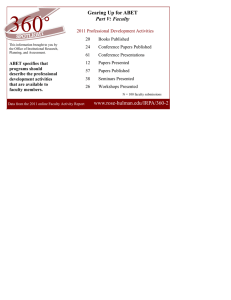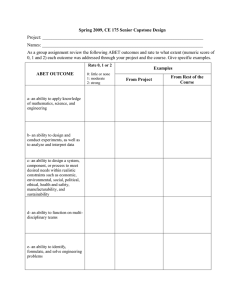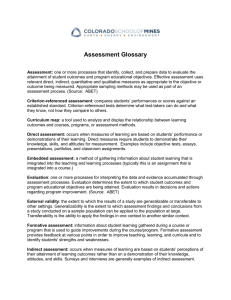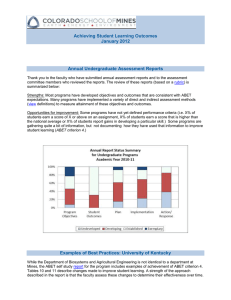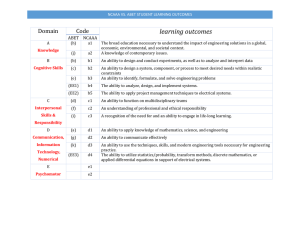Program Educational Objectives and Student Outcomes ( PDF )
advertisement
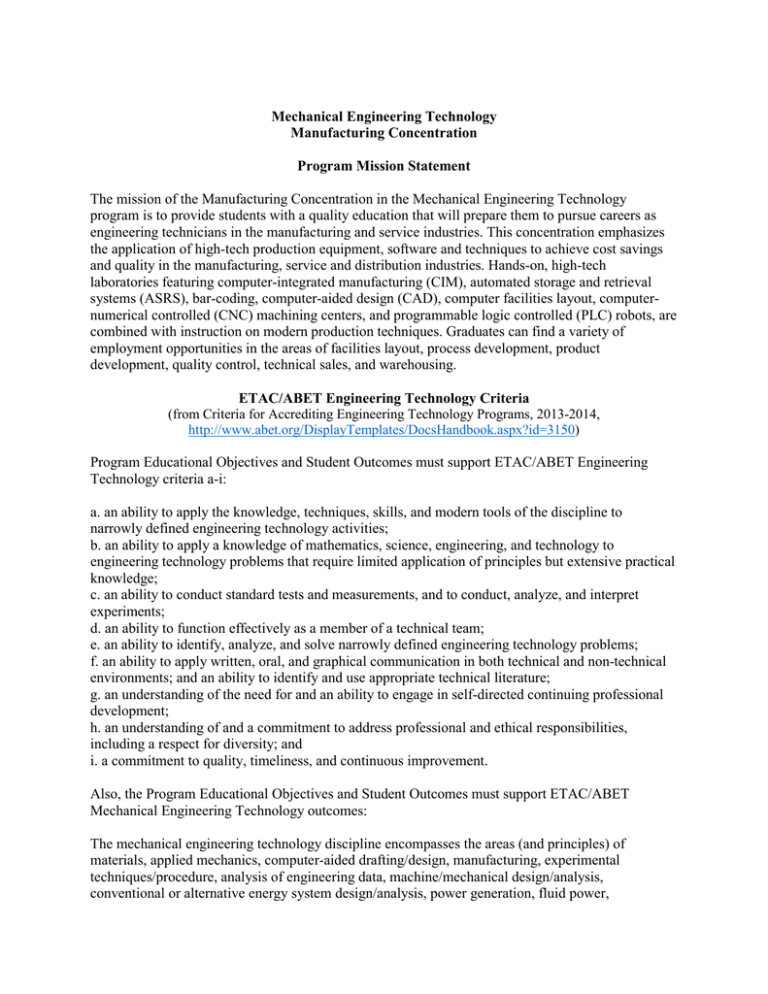
Mechanical Engineering Technology Manufacturing Concentration Program Mission Statement The mission of the Manufacturing Concentration in the Mechanical Engineering Technology program is to provide students with a quality education that will prepare them to pursue careers as engineering technicians in the manufacturing and service industries. This concentration emphasizes the application of high-tech production equipment, software and techniques to achieve cost savings and quality in the manufacturing, service and distribution industries. Hands-on, high-tech laboratories featuring computer-integrated manufacturing (CIM), automated storage and retrieval systems (ASRS), bar-coding, computer-aided design (CAD), computer facilities layout, computernumerical controlled (CNC) machining centers, and programmable logic controlled (PLC) robots, are combined with instruction on modern production techniques. Graduates can find a variety of employment opportunities in the areas of facilities layout, process development, product development, quality control, technical sales, and warehousing. ETAC/ABET Engineering Technology Criteria (from Criteria for Accrediting Engineering Technology Programs, 2013-2014, http://www.abet.org/DisplayTemplates/DocsHandbook.aspx?id=3150) Program Educational Objectives and Student Outcomes must support ETAC/ABET Engineering Technology criteria a-i: a. an ability to apply the knowledge, techniques, skills, and modern tools of the discipline to narrowly defined engineering technology activities; b. an ability to apply a knowledge of mathematics, science, engineering, and technology to engineering technology problems that require limited application of principles but extensive practical knowledge; c. an ability to conduct standard tests and measurements, and to conduct, analyze, and interpret experiments; d. an ability to function effectively as a member of a technical team; e. an ability to identify, analyze, and solve narrowly defined engineering technology problems; f. an ability to apply written, oral, and graphical communication in both technical and non-technical environments; and an ability to identify and use appropriate technical literature; g. an understanding of the need for and an ability to engage in self-directed continuing professional development; h. an understanding of and a commitment to address professional and ethical responsibilities, including a respect for diversity; and i. a commitment to quality, timeliness, and continuous improvement. Also, the Program Educational Objectives and Student Outcomes must support ETAC/ABET Mechanical Engineering Technology outcomes: The mechanical engineering technology discipline encompasses the areas (and principles) of materials, applied mechanics, computer-aided drafting/design, manufacturing, experimental techniques/procedure, analysis of engineering data, machine/mechanical design/analysis, conventional or alternative energy system design/analysis, power generation, fluid power, thermal/fluid system design/analysis, plant operation, maintenance, technical sales, instrumentation/control systems, and heating, ventilation, and air conditioning (HVAC), among others. As such, programs outcomes, based on specific program objectives, may have a narrower focus with greater depth, selecting fewer areas, or a broader spectrum approach with less depth, drawing from multiple areas. However, all programs must demonstrate an applied basis in engineering mechanics/sciences. Associate degree programs must demonstrate that graduates can apply specific program principles to the specification, installation, fabrication, test, operation, maintenance, sales, or documentation of basic mechanical systems depending on program orientation and the needs of their constituents. Program Educational Objectives Program Educational Objectives are based on student achievement 2-3 years after graduation. Within a few years of graduation, Mechanical Engineering Technology – Manufacturing concentration students are expected to: EO-1 attain successful and productive mechanical/manufacturing engineering technology or related careers with attention to ethical standards and effective communication; EO-2 engage in life-long learning activities, such as continued studies and/or professional workshops and conferences EO-3 engage in professional service, such as participation in professional society and/or community service Our department periodically reviews these objectives and as part of this review process, encourages comments from all interested parties: current students, alumni, prospective students, faculty, teaching assistants, those who hire or admit our graduates to other programs, members of related professional organizations, and colleagues from other educational institutions. Please send comments to our program coordinator Susan Bell, slbell3@southwest.tn.edu. Student Outcomes/Program Outcomes The Mechanical Engineering Technology – Manufacturing Concentration student will have demonstrated the following attributes upon graduation: PO-1 Communicate effectively through proper use of oral, written and graphic skills. Covers ABET criteria: a, c & f PO-2 Knowledge of basic machining processes, metrology, and GD&T for manufacturing. Covers ABET criteria: a, b & f and specific ETAC/ABET Mechanical Engineering Technology outcomes: materials & manufacturing. PO-3 The ability to use Computer-Aided Design (CAD) and solid modeling software to create mechanical drawings. Covers ABET criteria: a, b & f and ETAC/ABET Mechanical Engineering Technology outcomes: computer aided drafting/design PO-4 The ability to use logic to construct computer programs for solving CNC applications. Covers ABET criteria: a, b, e & i and ETAC/ABET Mechanical Engineering Technology outcomes: manufacturing PO-5 The ability to layout an efficient production area and industrial facility using analytical techniques and Computer-Aided Design (CAD) software. Covers ABET criteria: a, b, c, e & i and ETAC/ABET Mechanical Engineering Technology outcomes: manufacturing & computer aided drafting/design PO-6 A knowledge of basic statistical quality control concepts and their application for industry. Covers ABET criteria: a, b, c, e & i. PO-7 A knowledge of automation and computer-integrated manufacturing methods for industry. Covers ABET criteria: a, b, c, e & i and ETAC/ABET Mechanical Engineering Technology outcomes: manufacturing PO-8 Knowledge of basic electrical circuits and electro-mechanical devices. Covers ABET criteria: a, b & e and ETAC/ABET Mechanical Engineering Technology outcomes: power generation PO-9 Solve technical problems using algebra and trigonometry. Covers ABET criteria: a, b & e PO-10 Understand the importance of teamwork, lifelong learning, professional, ethical responsibility, respect for diversity, and commitment to quality, timeliness and continuous improvement. Covers ABET criteria: d, g, h & i.
